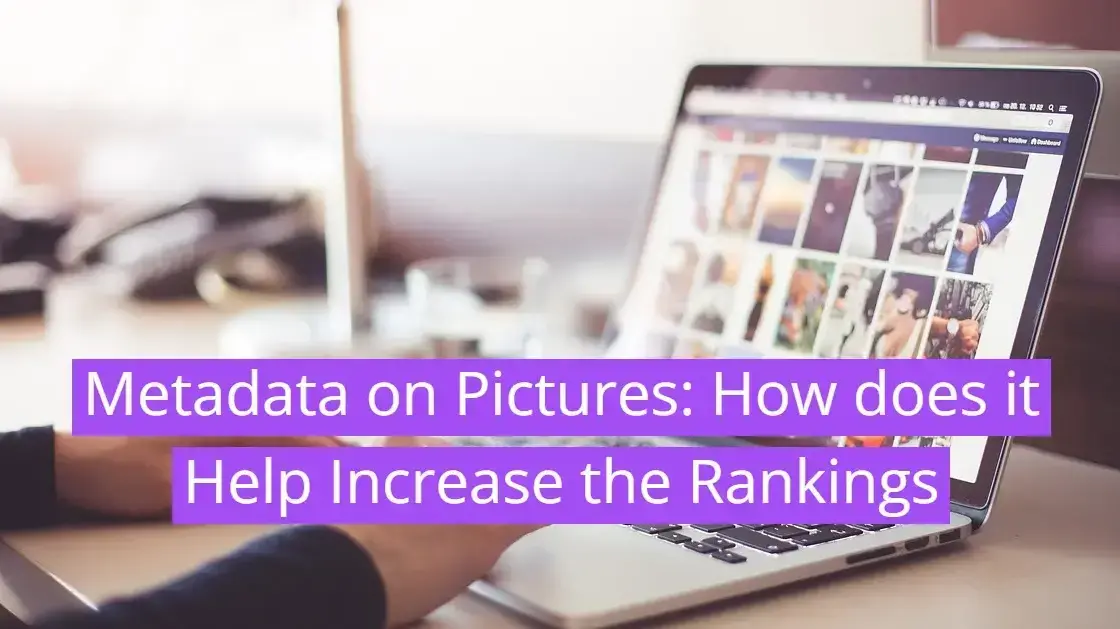Metadata on pictures? What is it? Is it necessary? You’ll learn all of this, plus how does it increase the rankings?
What is Image metadata?
Image metadata is like a hidden set of information attached to a digital picture. It's not visible in the image itself, but it provides valuable details about the photo. Most image files contain metadata embedded within them. Think of it as the "behind-the-scenes" information that tells you more about the image.
You can usually view and edit metadata using image editing software (like Adobe Photoshop or Lightroom), file explorers, or dedicated metadata viewers. Image metadata is important because of the following:
Organization and Search
Copyright and Licensing
Image Editing and Processing
Historical and Scientific Value
Organization and Search
Metadata makes it much easier to find specific images within a large collection. You can search by keywords, date, location, or other criteria.
Copyright and Licensing
Metadata helps ensure proper attribution and prevents copyright infringement.
Image Editing and Processing
Some software uses metadata to optimize image editing processes.
Historical and Scientific Value
Metadata can provide valuable historical and scientific information about the image and its creation.
Overall, image metadata can be a powerful tool for organizing, managing, and understanding digital images. It provides valuable context and information that goes beyond the visual content of the image itself.
Understanding Metadata
When it comes to understanding image metadata, you must know what information is embedded within the file. Here are the main types of data embedded in images:
- Technical Metadata
- Descriptive Metadata
- Administrative Metadata
Technical Metadata
Technical metadata includes details about how the image was created and its technical characteristics. For example:
Camera Model: The specific camera used to capture the image.
Lens: If the lens is attached to the camera.
Focal Length: The distance between the lens and the image sensor.
File Format: JPEG, TIFF, PNG, etc.
Dimensions: Width and height of the image in pixels.
Date and Time: When the image was captured.
GPS Coordinates: Location where the image was taken.
Descriptive Metadata
Descriptive metadata focuses on the information that describes the content of the image. Examples of this are:
Title: A brief name for the image.
Description: A more detailed explanation of the image's content.
Keywords: Tags that describe the image (example - "sunset," "beach," "portrait," "dog").
Subject: The main topic of the image.
Copyright Information: Ownership and usage rights.
Administrative Metadata
Administrative metadata is all about the iInformation related to the management and organization of the image. Example of this are:
Author/Creator: The photographer or artist who created the image. Source: Where the image originated from. Usage Rights: How the image can be used (e.g., personal, commercial, educational). Date Created: When the image was created. Date Modified: When the image was last edited or changed.
This structured data helps organize, search, and manage images effectively.
Metadata on Pictures: How does it Help Increase the Rankings?
Image metadata plays a crucial role in boosting search engine rankings, particularly in image search results. Here's a breakdown of how:
Improved Image Search Visibility
Enhanced User Experience
Improved Website Credibility
Leveraging Rich Snippets
Social Media Visibility
Improved Image Search Visibility
Metadata on pictures can improve visibility in image searches, especially in you’re using the following:
Keyword Relevance
Image Description
Keyword Relevance
Search engines like Google and Bing utilize image metadata (specifically keywords, captions, and descriptions) to understand the content of an image. By including relevant keywords, you directly tell search engines what the image depicts. This helps them match your images to user search queries more effectively. For example, an image of a "golden retriever puppy playing in the snow" should include keywords like "golden retriever," "puppy," "snow," "playful," and "dog."
Image Description
A detailed description provides valuable context to search engines. It helps them understand the scene, the mood, and any relevant information about the image. This enriched information allows search engines to better categorize and rank your images in image search results.
Enhanced User Experience
Metadata on pictures can enhance your website user’s experience under the following:
Accessibility
Contextual Relevance
Accessibility
Screen readers rely on image alt text (alternative text) to describe images to visually impaired users. Accurate and descriptive alt text not only improves accessibility but also signals to search engines that you prioritize user experience.
Contextual Relevance
Well-crafted metadata helps users understand the context of an image more quickly. When users can easily grasp the meaning of an image, they are more likely to engage with your content, spend more time on your website, and explore further. This positive user experience indirectly signals to search engines that your website is valuable and relevant.
Improved Website Credibility
Using metadata on images can improve your website’s credibility through the following:
Professionalism
Copyright and Licensing
Professionalism
Using proper metadata demonstrates a commitment to quality and attention to detail. It signals to search engines and users that you are a professional and reliable source of information.
Copyright and Licensing
Metadata can include copyright information and usage rights, which can help protect your images from unauthorized use and build trust with users.
Leveraging Rich Snippets
By implementing structured data markup (such as Schema.org), you can provide search engines with more detailed information about your images. This can lead to the appearance of rich snippets in search results, which can significantly increase click-through rates and improve your website's visibility. Rich snippets can display image previews, captions, and other relevant information directly in the search results, making your content more appealing to users.
Social Media Visibility
Many social media platforms utilize image metadata to display information about images when they are shared. For example, Facebook and Twitter often display image captions and descriptions in the post preview. This can increase engagement and drive traffic back to your website.
How can you rank well on the search engines with images?
Here are some best practices to help increase the rankings of your images:
- File Name Optimization
- Image Alt Text
- Image Size and Format
- Image Location and Context
- Structured Data (Schema Markup)
- Image Sitemaps
- Original and High-Quality Images
- Monitor Image Search Performance
File Name Optimization
Use descriptive filenames. Instead of generic names like "image1.jpg" or "IMG_0012.jpg," use descriptive filenames that include relevant keywords. For example, if you have an image of a woman with hiking books and the article is about best hiking boots, your image file name might be "best-hiking-boots-for-women.jpg"
Image Alt Text
Here are a few tips about creating a good image alt text:
Clear and Concise: Alt text is crucial for accessibility (screen readers) and SEO.
Describe the image accurately: "A woman hiking in a pair of comfortable, waterproof hiking boots."
Use relevant keywords naturally: Don't keyword stuff!
Keep it concise: Aim for 125 characters or less.
Image Size and Format
Make sure to optimize your imagesfor the Web. Use appropriate image formats (JPEG for photos, PNG for graphics with transparency) and compress them to reduce file size without sacrificing quality. Additionally, consider image dimensions by resizing images to the appropriate size for your website to improve loading speed.
Image Location and Context
It’s important to place images strategically. Ideally, you should place them near relevant text, above the fold (visible without scrolling), and even in blog posts and articles to break up text. You should also consider adding captions to provide additional context and keywords.
Structured Data (Schema Markup)
Help search engines understand your images. Use schema markup (like ImageObject) to provide more information to search engines about your images, such as:
Image URL
Name
Description
License
Image Sitemaps
Create an image sitemap. If you have a large number of images, create an image sitemap to help search engines discover and index them.
Original and High-Quality Images
Use original images whenever possible and especially avoid using stock photos that are overused. Also, make sure to retain image quality, like high-resolution images that are clear and visually appealing.
Monitor Image Search Performance
Track your image search performance in Google Search Console to see which images are ranking well and identify areas for improvement.
In Summary
In summary, it’s important to remember these key takeaways to increase the rankings on image metadata:
Focus on user experience: Make sure your images are relevant, high-quality, and enhance the user experience.
Provide clear and concise information: Help search engines understand what your images are about through descriptive filenames, alt text, and captions.
Technical optimization: Optimize image size and format to improve page loading speed.
While image metadata alone may not be the sole determinant of search engine rankings, it plays a vital role in improving image search visibility, enhancing user experience, and ultimately boosting your website's overall SEO performance. By carefully crafting and optimizing your metadata on pictures, you can give your website a significant edge in the competitive world of online search.
Frequently Asked Questions
What is metadata in WordPress?
Metadata, or meta tags, are small pieces of code embedded in a webpage's HTML that provide search engine bots with additional details about the page's content.
What is metadata in Object Storage and why is it important?
Metadata is descriptive information about stored objects, making it easier to categorize, search, and retrieve data efficiently.
Where is the meta description on a website?
To examine a web page's meta description in HTML, you can use Chrome's features. Right-click on the page and select 'view page source' for the raw HTML, or choose 'inspect' to see the HTML as rendered after JavaScript execution, which is typically what Google observes.
What are the implications of shared hosting on SEO and website rankings?
Slow loading speeds and frequent downtimes on shared hosting can negatively impact user experience and potentially affect SEO rankings.

Nile Flores is a long time professional blogger, as well as WordPress website designer and developer from the St. Louis Metro East. Nile blogs at NileFlores.com, where she’s passionate about helping website owners, whether they’re small business owners or bloggers. She teaches about Blogging, Social Media, Search Engine Optimization, Website Design, and WordPress. Additionally, Nile loves to speak at WordCamps (WordPress conferences) across the United States. When Nile isn’t knee-deep in coding, she’s a proud mom of a college student, and enjoys oil painting, cigar smoking, nail art design, and practicing traditional Okinawan kempo karate.
View all posts by Nile Flores




















